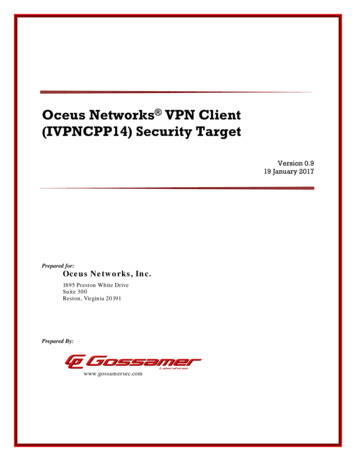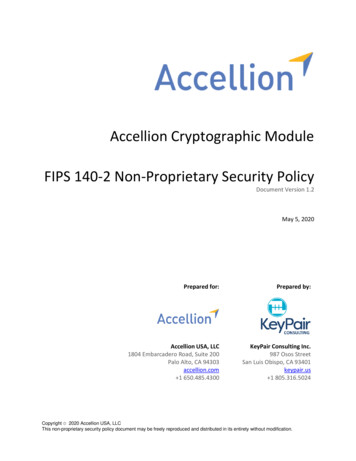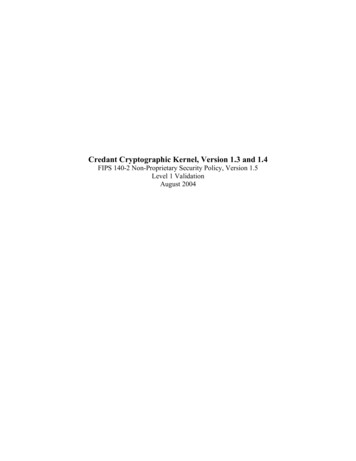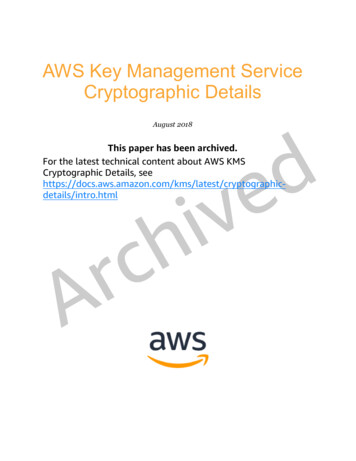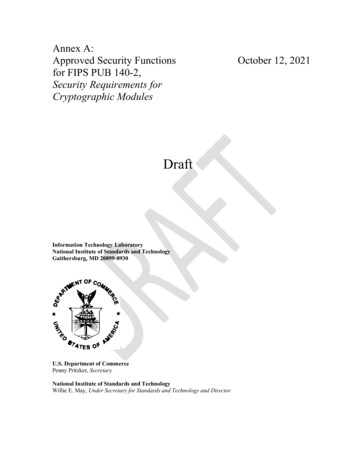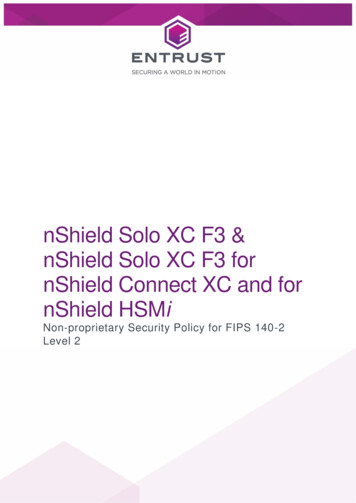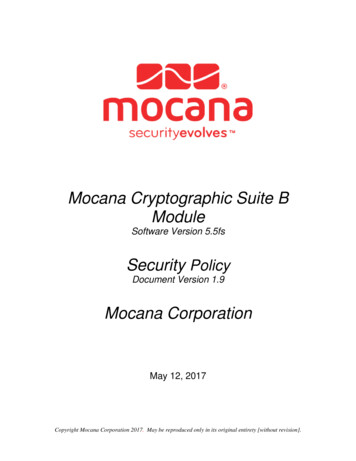
Transcription
Mocana Cryptographic Suite BModuleSoftware Version 5.5fsSecurity PolicyDocument Version 1.9Mocana CorporationMay 12, 2017Copyright Mocana Corporation 2017. May be reproduced only in its original entirety [without revision].
TABLE OF CONTENTS1. MODULE OVERVIEW. 32. SECURITY LEVEL . 43. MODES OF OPERATION . 5APPROVED MODE OF OPERATION . 5NON-FIPS APPROVED ALGORITHMS . 5NON-FIPS APPROVED MODE: . 64. PORTS AND INTERFACES. 65. IDENTIFICATION AND AUTHENTICATION POLICY . 6ASSUMPTION OF ROLES . 66. ACCESS CONTROL POLICY . 7ROLES AND SERVICES . 7OTHER SERVICES . 8DEFINITION OF CRITICAL SECURITY PARAMETERS (CSPS). 8DEFINITION OF PUBLIC KEYS: . 11DEFINITION OF CSPS MODES OF ACCESS . 127. OPERATIONAL ENVIRONMENT . 148. SECURITY RULES . 159. PHYSICAL SECURITY . 1710. MITIGATION OF OTHER ATTACKS POLICY . 1711. CRYPTOGRAPHIC OFFICER GUIDANCE . 17KEY DESTRUCTION SERVICE . 1712. DEFINITIONS AND ACRONYMS . 17Copyright Mocana Corporation 2017. May be reproduced only in its original entirety [without revision].
Mocana CorporationMocana Cryptographic Suite B Module Security Policy1. Module OverviewThe Mocana Cryptographic Suite B Module (Software Version 5.5fs) is a software only, multichip standalone cryptographic module that runs on a general purpose computer. The primarypurpose of this module is to provide FIPS Approved cryptographic routines to consumingapplications via an Application Programming Interface. The physical boundary of the module isthe case of the general purpose computer. The logical boundary of the cryptographic module isthe single library (libmss.a).The cryptographic module runs on the following operating environments:-Integrity O/S 5.0 on Freescale MPC8544ADS Development System-iOS-5 on iPad 2-iOS-6 on iPad 2-iOS-9.3 iPhone 5sThe cryptographic module is also supported on the following operating environments for whichoperational testing was not performed:-Linux x86-64 Kernel version 2.6.32-38 (Ubuntu 10.04)-iOS 7Note: the CMVP makes no statement as to the correct operation of the module or the securitystrengths of the generated keys when so ported if the specific operational environment is notlisted on the validation certificate.Page 3
Mocana CorporationMocana Cryptographic Suite B Module Security PolicyFigure 1 – Cryptographic Module Interface DiagramFigure 2 – Logical Cryptographic Boundary2. Security LevelThe cryptographic module meets the overall requirements applicable to Security Level 1 ofFIPS 140-2.Table 1 - Module Security Level SpecificationSecurity Requirements SectionLevelCryptographic Module Specification1Module Ports and Interfaces1Roles, Services and Authentication1Finite State Model1Physical SecurityN/AOperational Environment1Cryptographic Key Management1EMI/EMC1Self-Tests1Design Assurance1Mitigation of Other AttacksN/APage 4
Mocana CorporationMocana Cryptographic Suite B Module Security Policy3. Modes of OperationApproved mode of operationThe module supports multiple Approved modes of operation. During module initialization, aconsuming application can configure the module to utilize all, or any subset of the followingFIPS Approved algorithms:AES (ECB, CBC, OFB, CFB, CTR and GCM modes; E/D; 128, 192 and 256) – Certs.#2356 and #2096AES (CCM, CMAC 128, 192 and 256) – Certs. #2356 and #2096AES XTS (128 and 256) – Certs. #2356 and #2096Triple-DES (3-key and 2-key; TCBC mode; E/D) – Cert. #1333HMAC-SHA-1 – Cert. #1271HMAC-SHA-224 - Cert. #1271HMAC-SHA-256 - Cert. #1271HMAC-SHA-384 - Cert. #1271HMAC-SHA-512 - Cert. #1271SHA-1 - Cert. #1820SHA-224 - Cert. #1820SHA-256 - Cert. #1820SHA-384 - Cert. #1820SHA-512 - Cert. #1820RSA key generation, signature generation and verification (Gen Key X9.31; PKCS #11.5, Sig Gen and Sig Ver: 1024, 1536, 2048, 3072, 4096; PSS Sig Gen and Sig Ver:1024, 1536, 2048, 3072, 4096) - Cert. #1075DSA key generation, signature generation and verification (PQG Gen/Ver, Key Pair Gen,Sig Gen/Ver; 1024) - Cert. #655ECDSA key generation, public key validation, signature generation and verification(CURVES P; 192, 224, 256, 384, 521) - Cert. #307AES-CTR based DRBG - Cert. #221Non-FIPS Approved AlgorithmsWithin the FIPS Approved mode of operation, the module supports the following allowedalgorithms:Diffie-Hellman (key agreement; key establishment methodology provides 112 bits ofencryption strength; non-compliant less than 112 bits of encryption strength)RSA Key Wrapping (key wrapping; key establishment methodology provides between112 and 128 bits of encryption strength; non-compliant less than 112 bits of encryptionstrength)Page 5
Mocana Corporation--Mocana Cryptographic Suite B Module Security PolicyECDH (key agreement; key establishment methodology provides between 112 and 256bits of encryption strength; non-compliant less than 112 bits of encryption strength)NDRNGNon-FIPS Approved mode:In addition to the above algorithms, the following algorithms are available in the non-FIPSApproved mode of operation:DES, Blowfish, ARC2, ARC4, MD2, MD4, MD5, HMAC-MD5, AES EAX, AESXCBCRSA PKCS #1 v2.1 RSAES-OAEP encryption/decryptionFIPS 186-2 RNG, Dual EC DRBGDuring operation, the module can switch service by service between an Approved mode ofoperation and a non-Approved mode of operation. The module will transition to the nonApproved mode of operation when one of the above non-Approved security functions is utilizedin lieu of an Approved one. The module can transition back to the Approved mode of operationby utilizing an Approved security function4. Ports and InterfacesThe physical ports of the module are provided by the general purpose computer on which themodule is installed. The logical interfaces are defined as the API of the cryptographic module.The module’s API supports the following logical interfaces: data input, data output, controlinput, and status output.5. Identification and Authentication PolicyAssumption of rolesThe Mocana Cryptographic Suite B Module shall support two distinct roles (User andCryptographic Officer). The cryptographic module does not provide any identification orauthentication methods of its own. The Cryptographic Officer and the User roles are implicitlyassumed based on the service requested.Table 2 - Roles and Required Identification and AuthenticationRoleType of AuthenticationAuthentication DataUserN/AN/ACryptographic OfficerN/AN/APage 6
Mocana CorporationMocana Cryptographic Suite B Module Security Policy6. Access Control PolicyRoles and ServicesTable 3 – Services Authorized for Use in the Approved modes of operationRoleUserCryptographic-OfficerAuthorized Services Self-tests Show Status Read Version DH Key Generation DH Key Exchange ECDH Key Exchange RSA Key Generation RSA Signature Generation RSA Signature Verification RSA Key Wrapping Encryption RSA Key Wrapping Decryption DSA Key Generation DSA Signature Generation DSA Signature Verification ECDSA Key Generation ECDSA Signature Generation ECDSA Signature Verification AES Encryption AES Decryption AES Message Authentication Code TDES Encryption TDES Decryption SHA-1 SHA-224/256 SHA-384/512 HMAC-SHA1 Message Authentication Code HMAC-SHA224/256 Message Authentication Code HMAC-SHA384/512 Message Authentication Code AES-CTR DRBG Random Number Generation Key DestructionPage 7
Mocana CorporationMocana Cryptographic Suite B Module Security PolicyOther ServicesTable 4 – Services Authorized for Use in the non-Approved mode of operationRoleAuthorized ServicesUserCryptographic-Officer Self-tests Show Status Read Version DES Encryption DES Decryption Blowfish Encryption Blowfish Decryption ARC2, ARC4 Encryption ARC2, ARC4 Decryption MD2 Hash MD4 Hash MD5 Hash HMAC-MD5 Message Authentication Code AES EAX Encryption AES EAX Decryption AES XCBC Encryption AES XCBC Decryption RSA PKCS #1 v2.1 RSAES-OAEP Encryption RSA PKCS #1 v2.1 RSAES-OAEP Decryption FIPS 186-2 Random Number GenerationDual EC DRBG Random Number Generation The cryptographic module supports the following service that does not require an operator toassume an authorized role: Self-tests: This service executes the suite of self-tests required by FIPS 140-2. It isinvoked by reloading the library into executable memory.Definition of Critical Security Parameters (CSPs)The following are CSPs that may be contained in the module:Page 8
Mocana CorporationMocana Cryptographic Suite B Module Security PolicyTable 5: CSP try /OutputDestructionDH PrivateComponentsUsed to derive thesecret session keyduring DH keyagreement protocolInternally usingthe AES-CTRDRBGTemporarily involatile RAMN/AAn applicationprogram which usesthe API may destroythe key. The KeyDestruction servicezeroizes this CSP.ECDH PrivateComponentsUsed to derive thesecret session keyduring ECDH keyagreement protocolInternally usingthe AES-CTRDRBGTemporarily involatile RAMN/AAn applicationprogram which usesthe API may destroythe key. The KeyDestruction servicezeroizes this CSP.Seed and SeedKeysUsed to seed theDRBG for keygenerationInternally viaNDRNG orExternallyTemporarily involatile RAMEntry:Plaintext ifgeneratedexternallyOutput:N/AAutomatically afteruseRSA Private KeyUsed to create RSAdigital signaturesMay begeneratedinternally usingthe AES-CTRDRBG orgeneratedexternallyTemporarily involatile RAMEntry:Plaintext ifgeneratedexternallyOutput:PlaintextAn applicationprogram which usesthe API may destroythe key. The KeyDestruction servicezeroizes this CSP.RSA KeyWrapping PrivateKeyUsed for RSA KeyWrapping decryptionoperationMay begeneratedinternally usingthe AES-CTRDRBG orgeneratedexternallyTemporarily involatile RAMEntry:Plaintext ifgeneratedexternallyOutput:PlaintextAn applicationprogram which usesthe API may destroythe key. The KeyDestruction servicezeroizes this CSP.DSA Private KeyUsed to create DSAdigital signaturesMay begeneratedinternally usingthe AES-CTRDRBG orgeneratedexternallyTemporarily involatile RAMEntry:Plaintext ifgeneratedexternallyOutput:PlaintextAn applicationprogram which usesthe API may destroythe key. The KeyDestruction servicezeroizes this CSP.ECDSA PrivateKeyUsed to create DSAdigital signaturesMay begeneratedinternally usingthe AES-CTRDRBG orgeneratedexternallyTemporarily involatile RAMEntry:Plaintext ifgeneratedexternallyOutput:PlaintextAn applicationprogram which usesthe API may destroythe key. The KeyDestruction servicezeroizes this CSP.Page 9
Mocana CorporationMocana Cryptographic Suite B Module Security PolicyKeyDescription/UsageGenerationStorageEntry /OutputDestructionTDES KeyUsed during TDESencryption anddecryptionExternally.Temporarily involatile RAMEntry:PlaintextOutput:N/AAn applicationprogram which usesthe API may destroythe key. The KeyDestruction servicezeroizes this CSP.AES KeysUsed during AESencryption,decryption, andCMAC operationsExternally.Temporarily involatile RAMEntry:PlaintextOutput:N/AAn applicationprogram which usesthe API may destroythe key. The KeyDestruction servicezeroizes this CSP.HMAC KeysUsed during HMACSHA-1, 224, 256, 384,512 operationsExternally.Temporarily involatile RAMEntry:PlaintextOutput:N/AAn applicationprogram which usesthe API may destroythe key. The KeyDestruction servicezeroizes this CSP.Page 10
Mocana CorporationMocana Cryptographic Suite B Module Security PolicyDefinition of Public Keys:The following are the public keys contained in the module:Table 6: Public Key try/OutputDH PublicComponentUsed to derive the secretsession key during DH keyagreement protocolInternally usingthe AES-CTRDRBGTemporarily involatile RAMEntry: Receive ClientPublic Componentduring DH exchange.Output: TransmitHost PublicComponent duringDH exchangeECDH PublicComponentUsed to derive the secretsession key during ECDHkey agreement protocolInternally usingthe AES-CTRDRBGTemporarily involatile RAMEntry: Receive ClientPublic Componentduring DH exchange.Output: TransmitHost PublicComponent duringDH exchangeRSA PublicKeysUsed to verify RSAsignaturesMay begeneratedinternally usingthe AES-CTRDRBG orgeneratedexternallyTemporarily involatile RAMInput: Plaintext ifgenerated externally tOutput: PlaintextRSA KeyWrapping PublicKeysUsed for RSA KeyWrapping encryptionoperationMay begeneratedinternally usingthe AES-CTRDRBG orgeneratedexternallyTemporarily involatile RAMInput: Plaintext ifgenerated externallyOutput: PlaintextDSA PublicKeysUsed to verify DSAsignaturesMay begeneratedinternally usingthe AES-CTRDRBG orgeneratedexternallyTemporarily involatile RAMInput: Plaintext ifgenerated externallyOutput: PlaintextECDSA PublicKeysUsed to verify ECDSAsignaturesMay begeneratedinternally usingthe AES-CTRDRBG orgeneratedexternallyTemporarily involatile RAMInput: Plaintext ifgenerated externallyOutput: PlaintextPage 11
Mocana CorporationMocana Cryptographic Suite B Module Security PolicyDefinition of CSPs Modes of AccessThe following table defines the relationship between access to CSPs and the different moduleservices.Table 7 – CSP Access Rights within Roles & ServicesRoleC.O.ServiceCryptographic Keys and CSPs Access OperationUserXDH KeyGenerationUse DH ParametersGenerate DH Key pairXDH Key ExchangeUse DH Private ComponentGenerate DH shared secretXECDH KeyExchangeUse ECDH Private ComponentGenerate ECDH shared secretXRSA KeyGenerationGenerate RSA Public/Private Key pairXRSA SignatureGenerationUse RSA Private KeyGenerate RSA SignatureXRSA SignatureVerificationUse RSA Public KeyVerify RSA SignatureXRSA KeyWrappingEncryptionUse RSA Public KeyPerforms Key Wrapping EncryptionXRSA KeyWrappingDecryptionUse RSA Private KeyPerforms Key Wrapping DecryptionXDSA KeyGenerationGenerate DSA Key Pair for Signature Generation/VerificationXDSA SignatureGenerationUse DSA Private KeyGenerate DSA SignatureXDSA SignatureVerificationUse DSA Public KeyVerify DSA SignatureXECDSA KeyGenerationGenerate ECDSA Key Pair for Signature Generation/VerificationXECDSA SignatureGenerationUse DSA Private KeyGenerate ECDSA SignatureXECDSA SignatureVerificationUse ECDSA Public KeyVerify ECDSA SignatureXAES EncryptionUse AES KeyXAES DecryptionUse AES KeyXAES MessageUse AES KeyPage 12
Mocana CorporationRoleC.O.Mocana Cryptographic Suite B Module Security PolicyServiceCryptographic Keys and CSPs Access OperationUserAuthenticationCodeXTDES EncryptionUse TDES KeyXTDES DecryptionUse TDES KeyXSHA-1Generate SHA-1 Output; no CSP accessXSHA-224/256Generate SHA-224/256 Output; no CSP accessXSHA-384/512Generate SHA-384/512 Output; no CSP accessXHMAC-SHA-1MessageAuthenticationCodeUse HMAC-SHA-1 KeyGenerate HMAC-SHA-1 OutputXHMAC-SHA224/256 MessageAuthenticationCodeUse HMAC-SHA-224/256 KeyGenerate HMAC-SHA-224/256 OutputXHMAC-SHA384/512 MessageAuthenticationCodeUse HMAC-SHA-384/512 KeyGenerate HMAC-SHA-384/512 OutputXAES-CTR DRBGRandom NumberGenerationUse Seed Key to generate random numberDestroy Seed Key after useXKey DestructionDestroy All CSPsXShow StatusN/AXSelf-TestsN/AXRead VersionN/APage 13
Mocana CorporationMocana Cryptographic Suite B Module Security Policy7. Operational EnvironmentThe FIPS 140-2 Area 6 Operational Environment requirements are applicable because theMocana Cryptographic Suite B Module operates in a modifiable operational environment.Operational testing of the module was performed on the following environments:Integrity O/S 5.0-iOS-5-iOS-6-iOS-9.3The module is delivered as a binary library to be linked into an application in a similar manner tothe shared library version of the Mocana cryptographic module. Using this library whenbuilding the application, in contrast to a shared library, means that the integrity of the binarycode in the library must be tested within the fully linked executable code of the application thatincorporates it.The module is delivered as a library file (e.g. “libmss.a”) compatible with the target executionenvironment of the application.A signature file (e.g. “libmss.a.sig”) is delivered that ensures that the above library file was notchanged (HMAC-SHA1 fingerprint);An executable development tool (e.g. “secure link”) is delivered that is compatible with the hostdevelopment environment in which the application is being built;To ensure an unbroken “chain” of integrity checks, the “secure link” development tool mustperform a self integrity check to ensure that it has not been modified. It will also verify thedelivered library file and signature file. It will then act as a front end to the normal developmenttool linker to perform the final link with this library into an application. Finally it will sign thecryptographic-module within the executable and store the signature into the executable. If thedeveloper does not use the “secure link” development tool to perform the final link step of theirapplication, the cryptographic module will fail its startup integrity check. The “secure link”development tool performs these steps:1.Perform integrity check on itself using the same procedure as that to be used by the developer'sapplication as described below;2.Locate the library file and its signature file;3.Validate the signature with the data stored in the library file ( HMAC-SHA1 finger print ofwhole file);4.Execute the linking step of the application with the validated library (using the linker andlinker options as specified by the developer);5.Create a new HMAC-SHA1 fingerprint including the sections (e.g. “.text” and “.rodata”) of thecreated executable file that covers the library crypto code and constants. This step excludes theapplication’s code and constants, and any other sections by fingerprinting between top andbottom markers that are used to wrap the library code and constants;Page 14
Mocana CorporationMocana Cryptographic Suite B Module Security Policy6.“Stamp” the executable file with the generated HMAC-SHA1 value, so during the applicationstartup the integrity of the library code and constants can be validated;Integrity Check at Application StartDuring application startup, the application will check the integrity of the library code andconstants during the module startup function. It verifies the integrity by executing the HMACSHA1 fingerprint algorithm in memory and comparing the result with the value found in aspecific place in the executable application. This is analogous to the HMAC-SHA1 calculationand verification against the signature file utilized in the shared object version of the MocanaCryptographic Suite B Module.8. Security RulesThe Mocana Cryptographic Suite B Module design corresponds to the following security rules.This section documents the security rules enforced by the cryptographic module to implementthe security requirements of this FIPS 140-2 Level 1 module.1. The cryptographic module shall provide two distinct roles. These are the User role and theCryptographic Officer role.2. The cryptographic module does not provide any operator authentication.3. The cryptographic module shall encrypt/decrypt message traffic using the Triple-DES orAES algorithms.4. The cryptographic module shall perform the following self-tests:Power-up Self-Tests: Cryptographic Algorithm Tests:AES-ECB, CBC, OFB. CFB, CCM, , CTR, GCM, and XTS Encrypt and DecryptKnown Answer TestsAES-CMAC Generation and Verification Known Answer TestsTriple-DES CBC Encrypt and Decrypt Known Answer TestsHMAC-SHA-1 Known Answer TestHMAC-SHA-224 Known Answer TestHMAC-SHA-256 Known Answer TestHMAC-SHA-384 Known Answer TestHMAC-SHA-512 Known Answer TestSHA-1 Known Answer TestSHA-224 Known Answer TestSHA-256 Known Answer TestSHA-384 Known Answer TestSHA-512 Known Answer TestRSA Encrypt and Decrypt Known Answer TestsRSA Sign and Verify Known Answer TestsDSA Pairwise Consistency TestPage 15
Mocana Corporation-Mocana Cryptographic Suite B Module Security PolicyECDSA Pairwise Consistency TestECDH Pairwise Consistency TestDH Pairwise Consistency TestAES-CTR DRBG Known Answer Test Software Integrity Test: HMAC-SHA-1 Critical Functions Tests: N/AConditional Tests: DSA Pairwise Consistency Test RSA Pairwise Consistency Test ECDSA Pairwise Consistency Test FIPS 186-2 RNG Continuous Test AES-CTR DRBG Continuous Test Dual EC DRBG Continuous Test NDRNG Continuous TestThe module can be configured to utilize all or only a subset of the Approved security functionslisted in Section 3 above. Only the self-tests of the algorithms that are to be utilized will be runat power-up. Upon re-configuration from one Approved mode of operation to another, themodule will reinitialize and perform all power-up self-tests associated with the new Approvedmode of operation.5. At any time, the operator shall be capable of commanding the module to perform the powerup self-tests by reloading the cryptographic module into memory.6. The cryptographic module is available to perform services only after successfully completingthe power-up self-tests.7. Data output shall be inhibited during key generation, self-tests, zeroization, and error states.8. Status information shall not contain CSPs or sensitive data that if misused could lead to acompromise of the module.9. The module shall not support concurrent operators.10. DES, Blowfish, ARC2, ARC4, MD2, MD4, MD5, HMAC-MD5, AES EAX, AES XCBC,RSA PKCS #1 v2.1 RSAES-OAEP encryption/decryption, FIPS 186-2 RNG, and Dual ECDRBG are not allowed for use in the FIPS Approved mode of operation. When thesealgorithms are used, the module is no longer operating in the FIPS Approved mode ofoperation. It is the responsibility of the consuming application to zeroize all keys and CSPsprior to and after utilizing these non-Approved algorithms. CSPs shall not be shared betweenthe Approved and non-Approved modes of operation.Page 16
Mocana CorporationMocana Cryptographic Suite B Module Security Policy9. Physical SecurityThe FIPS 140-2 Area 5 Physical Security requirements are not applicable because the MocanaCryptographic Suite B Module is software only.10. Mitigation of Other Attacks PolicyThe module has not been designed to mitigate any specific attacks outside the scope of FIPS140-2 requirements.11. Cryptographic Officer GuidanceThe operating system running the Mocana Cryptographic Suite B Module must be configured ina single-user mode of operation.Key Destruction ServiceThere is a context structure associated with every cryptographic algorithm available in thismodule. Context structures hold sensitive information such as cryptographic keys. Thesecontext structures must be destroyed via respective API calls when the application software nolonger needs to use a specific algorithm any more. This API call will zeroize all sensitiveinformation including cryptographic keys before freeing the dynamically allocated memory. Seethe Mocana Cryptographic API Reference for additional information.12. Definitions and AcronymsAESAdvanced Encryption StandardAPIApplication Program InterfaceCOCryptographic OfficerCSPCritical Security ParameterDESData Encryption StandardDHDiffie-HellmanDRBGDeterministic Random Bit GeneratorDSADigital Signature AlgorithmECDHElliptic Curve Diffie-HellmanECDSAElliptic Curve Digital Signature AlgorithmEMCElectromagnetic CompatibilityEMIElectromagnetic InterferenceFIPSFederal Information Processing StandardPage 17
Mocana CorporationMocana Cryptographic Suite B Module Security PolicyHMACKeyed-Hash Message Authentication CodeRAMRandom Access MemoryRNGRandom Number GeneratorRSARivest, Shamir and Adleman AlgorithmTDESTriple-DESSHASecure Hash AlgorithmSOShared ObjectPage 18
RSA Private Key Used to create RSA digital signatures May be generated internally using the AES-CTR DRBG or generated externally Temporarily in volatile RAM Entry: Plaintext if generated externally Output: Plaintext An application program which uses the API may destroy the key. The Key Destruction service zeroizes this CSP. RSA Key
